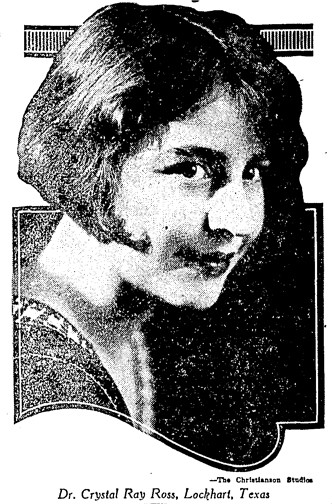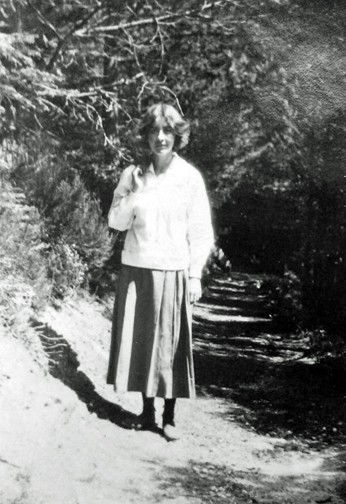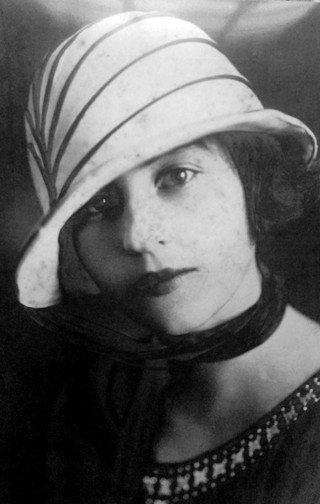Crystal Ross, 1900 – 1995
Crystal Ray Ross was born on July 2, 1900 in Lockhart, Texas. She earned a BA from the University of Texas at Austin in 1919 and an MA in English from Columbia University in 1921. After teaching English at the University of Texas, she moved to France around 1922 and enrolled at the Université de Strasbourg. Ross worked under Fernand Baldensperger, a professor and literary critic known as one of the founders of the discipline of Comparative Literature. She earned her "Doctorat ès Lettres" in 1925, with a dissertation written in French that compared the authors O. Henry and Guy de Maupassant. Ross was among the first women to earn a doctorate in France (Austin Statesman, August 9, 1925, A1).
Before traveling to Paris, Ross became acquainted with writer John Dos Passos at the memorial for a mutual friend in New York:
There was an instant affinity with Dos when we met at the services for Mickey, our relationship bonded, in a sense, by a friend who had meant a great deal to us both [...] Since I was leaving for France in mid-September, Dos and I didn't have much time together then, but we wrote often and during the three years that followed we discovered that our values were the same, our backgrounds similar, and almost everything we saw and did was in terms of each other (Carr 194).
Ross stayed at the University Women's Club for a few months in the spring of 1924 while visiting Dos Passos in Paris (Hansen 135). During this period she accepted his marriage proposal, even though she was not convinced their relationship would last and did not want to compromise her independence (Morris 13).
Dos Passos invited her to meet Ernest Hemingway and his first wife, Hadley Richardson, at La Closerie des Lilas, a favorite Montparnasse haunt for writers. The four hatched a plan to travel to Pamplona, Spain that summer. Hemingway enlisted several others to join the group, including fellow writers Robert McAlmon and Donald Ogden Stewart, and they all set off in July 1924. Ross and Dos Passos left first, traveling by train to southern France and then hiking over the Pyrenees into Spain. The others soon followed and the party managed to reach Pamplona in time for the annual Feria del Toro. They spent their days watching bullfighting and their nights drinking heavily. Dos Passos was especially pleased that Ross was on the trip and wrote about it years later:
I was discovering the truth of Benjamin Franklin's old saying: 'A man and a woman are like a pair of scissors. Neither one is good without the other.' Between us we built ourselves a sort of private box from which we looked out at all these goings on, in them but not of them (Carr 201).
After the trip to Pamplona, Ross returned to Strasbourg via Paris while Dos Passos set off on another hiking trip to Andorra with friends before heading back to New York. The couple stayed in touch and made efforts to see one another but it became clear that the romance was not working. Ross broke off the engagement but she and Dos Passos remained friends.

Ross sailed back to the U.S. in early June 1925, just a month before her 25th birthday. She returned to work at the University of Texas as a professor of Comparative Literature. In 1926, she became head of the English department at Southern Methodist University.
On June 25, 1927, Ross married Lewis Meriwether Dabney, Jr., a Harvard-educated lawyer who became a federal judge. They moved from Dallas to Washington, D.C., where he served as counsel for the Securities and Exchange Commission from 1937 – 1940. He then practiced law in New York.
Following her marriage, Ross gave up her university career, but she likely inspired her sons' vocations, since they both became literary scholars and educators. Her son Lewis M. Dabney (born in 1932) earned a PhD in English literature from Columbia University. He taught English at Smith and Vassar before transferring to the University of Wyoming, where he served as a professor for over thirty years. A few years before his death at the age of 83, he wrote a book about the lifelong friendship between John Dos Passos and his mother (Weber 24). Her younger son, Ross H. Dabney, was born in 1934. After obtaining a PhD in English literature from Harvard, he taught English at Smith College, the University of Virginia, Mount Holyoke College, and ended his career at Sweet Briar College.
Though it does not seem that Ross kept in touch with Hemingway, she was immortalized in the first pages of his 1926 masterpiece, The Sun Also Rises, the quintessential novel of the "Lost Generation" in Paris:
I know a girl in Strasbourg who can show us the town...She's been there two years and knows everything there is to know about the town. She's a swell girl.
Sources
- Carr, Virginia Spencer. Dos Passos: A Life. Evanston Illinois: Northwestern University Press, 2004.
- "Crystal Ray Ross Returns From France." The Austin Statesman, Aug 9, 1925, p. A1. ProQuest Historical Newspapers.
- "First Lady of Texas Hostess at Breakfast." The Austin American Statesman, June 26, 1927, p. A1. ProQuest Historical Newspapers.
- "Lockhart Girl is Married: Many Attend. Special to Sunday American-Statesman, The Austin American, June 26, 1927, p. 3. ProQuest Historical Newspapers.
- "Lewis M. Dabney, Jr., '21." Princeton Alumni Weekly 1986, Memorials, p. 18.
- Morris, James McGrath. The Ambulance Drivers: Hemingway, Dos Passos, and a Friendship Made and Lost in War. Boston, Massachusetts: Da Capo Press, 2017.
- Morris, James McGrath. "Meet the Dallas woman who dated Dos Passos, hiked with Hemingway and appears in 'The Sun Also Rises.'" The Dallas Morning News, July 5, 2017.
- "Ross Dabney, '55." Princeton Alumni Weekly online.
- "The Sunday Morning Photographic Review of Beauty, Culture and Youth: The Pictures." The Austin Statesman ; Aug 9, 1925, p. A1. ProQuest Historical Newspapers.
- Weber, Bruce. "Lewis M. Dabney, 83, Scholar Who Made Edmund Wilson The Focus of His Life's Work." New York Times, Dec 27, 2015, p. 24. ProQuest Historical Newspapers.

